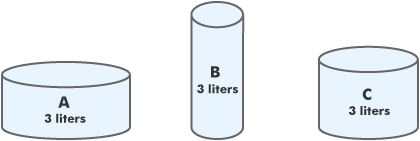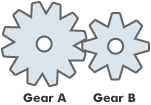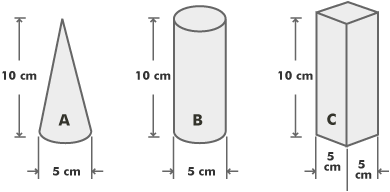 |
|
 |
Tickle has
examined your scores in five sectors of career talent to arrive at
your personalized aptitude profile. Based on your test results, your
greatest strengths are:
john, your primary
career talent is Spatial Ability.
The ability to
visualize objects in three-dimensional space can give you an unusual
view of the world. You appear to understand how figures can be
manipulated and take on new forms. Because of this talent, you can
probably imagine new designs easily, including anything from floor
plans to page layouts and even 3D product prototypes. People like
you are usually aces when it comes to putting together
assemble-it-yourself furniture or other household items whether
the items arrive with instructions or not.
Your rare talent
can make you less likely than most people to be content with the
same old thing. As a result, in your work life you might enjoy
focusing on visual innovation and proposing new ideas. Your ability
to conceptualize objects in their completed form can make you a
natural designer or engineer. Your spatial skills can also help you
understand the finer points of how things work. Typically, new
computer programs or specialized office equipment are no sweat to
you. In a world where technology changes so rapidly, you may also
find yourself rewarded for your ability to adapt.
Your secondary
career talent is Mechanical Ability.
Given this
talent, you're most likely curious about how things work and may
enjoy tinkering with machines. Have you ever taken something apart
just to see how it would fit back together? If this sounds like you,
you may have earned the reputation around your household as a real
Mr. or Ms. Fix-It. At times, people like you can be both
self-sufficient and a great help to others because when it's time to
change a car's oil or tighten a leaky faucet, you can be just the
right person to get the job done.
Having high mechanical
abilities can also mean that you possess an almost intuitive
understanding of physics and spatial reasoning. This can make you a
great builder or give you a talent for creating useful new products.
Your mechanical skills allow you plenty of career options and the
chance to work in multiple settings. No matter which opportunity you
choose, chances are that you'll enjoy working with your hands or
seeing the tangible result of your efforts.
|
|
|
 |
Now that you know
the two greatest strengths of your true talent profile, you might
want to know how we generated this summary of your skills.
While you were answering the test questions, we measured
your skills on five distinct talents: abstract reasoning, numerical
ability, verbal ability, spatial ability, and mechanical ability.
As you look at your complete talent profile, including your
primary and secondary strengths, you may notice that you can receive
the same score on more than one of your talents. Don't worry, that's
very common. If some of your talents share the same score, it simply
means you're equally good at all of those skills.
Here's how
your talent profile is ranked. First we calculated your overall
score for each talent. The higher the score, the higher it is ranked
in your talent profile. But what happens when you receive the same
score on different skills? In those cases, we looked at how
difficult it is for people to get high scores on those
particular talents, then ranked those talents in order of
difficulty.
Spatial ability refers to your level of ease in
understanding the relationship between objects and physical space.
Tickle's experts tested not only your ability to recognize how
shapes can be manipulated but also how they would look if their
appearance were altered in some way. Having an understanding of
object rotation in a three-dimensional space is another aspect
critical to this skill.
You scored a 10 out of 10 on
our measure of spatial ability. People who score high in this talent
tend to do best in professions that emphasize these unique spatial
skills.
 |
|
 |
 |
 |
Career success profile: Meet
Alexis
Alexis has been working in sales for years. In
her present role, she helps small businesses purchase office
furniture suitable for their needs. Although Alexis does a
fair job and her clients seem to like her well enough, many of
Alexis' colleagues seem much more suited for their roles than
she is. They could talk about sales for hours on end, while
she'd prefer to think about almost anything else but
work.
One day, Alexis was assigned to assist an
architectural firm in choosing its furniture. She spent
significant time with the architects at their workplace and
even had the chance to learn about some of their projects.
When Alexis asked one of the architects about some details on
a particular floor plan, he noticed that even as a novice she
had a good eye and some interesting ideas about the project.
He complimented Alexis on her intuitive understanding of
design and layouts and suggested that she should consider a
career change. He told her she had a real knack for
architecture.
Over the next few months, the architect's
comments stayed with Alexis. Then one day she got serious
about the idea of a career switch and began mulling over the
pros and cons. Even though she wasn't the best salesperson,
she made a decent living and enjoyed having money to spend on
herself. At the same time, she fantasized about going to work
every day and doing something that felt natural to
her.
Eventually, Alexis decided that in the short term,
she would stay in sales to build up her bank account. However,
she decided that in two years, she would apply to architecture
schools and make a dramatic career change. Knowing that she'd
made a plan for her future made Alexis feel better about her
present job and excited about the new experiences to come. She
is already studying for her college entrance exams and puts
money away each month for tuition.
|
 |
 |
 |
 |
 |
 |
 |
|
 |
 |
 |
Skill builder: Crank up the
Mozart
Researchers in neuropsychology have discovered
that listening to or playing classical music significantly
enhances spatial reasoning skills. This increase in spatial
abilities is called the Mozart Effect (Rauscher, Shaw, and Ky,
1993).
During a series of experiments, researchers
found that both children and college-age students performed
significantly better on spatial reasoning tasks after
listening to classical music. The key appears to be that
complex music, such as classical music, is useful in
developing higher cognitive functions. Taking up a musical
instrument like the piano seems to greatly increase the
effects, as well. So not only can it be enjoyable to listen to
classical music or learn an instrument, but it's good for your
brain, too. For more information on how your brain functioning
influences your judgments, check out Tickle's The Brain
Test: What Your Brain Says About How You Think and Learn.
|
 |
 |
 |
 |
 |
 |
Mechanical ability refers to your aptitude for understanding
the workings of machines and tools. A certain degree of precision
and practical thinking is needed for this type of skill.
You
scored a 10 out of 10 on our measure of mechanical ability.
People who score high on this talent do well in professions that
draw on this skill.
 |
|
 |
 |
 |
Career success profile: Meet
Nathan
Nathan was a natural at building and restoring
homes. In his early twenties, he had already planned to go
into construction. However, because Nathan got married very
young, his need for a stable income outweighed this original
plan. Consequently, Nathan went into insurance sales, which
offered him both steady pay and job security. As time went on,
Nathan remained somewhat satisfied with his insurance job but
would still spend every weekend on home projects.
Years
later, once their two children were raised, Nathan admitted to
his wife, Maria, that he wished he could do something
different. He also told her that he didn't feel that his
original passion for construction was a possibility. He was
older now and his body could no longer handle the harsh
physical requirements. Maria suggested that there might be
alternatives that would still allow him to build things and
work with his hands. Nathan took that idea to heart,
remembering that he'd been very happy restoring furniture for
family and friends. Most of the time, he'd done those projects
as personal favors. Still, he recalled how everyone had
marveled at his abilities. With his wife's encouragement and
financial savvy, Nathan decided to take a chance on starting
his own custom furniture restoration business. The work was
tough but not as grueling as construction. Nathan started out
small, but through word of mouth, he gained a steady clientele
and a rewarding second career doing something he loved.
|
 |
 |
 |
 |
 |
 |
 |
|
 |
 |
 |
Skill builder: Hit the
books
Believe it or not, for most people the first step
in gaining mechanical aptitude is to get out of the workshop
and into the library. Usually what keeps people from
developing their mechanical aptitude is their unfamiliarity in
working with power tools. However, handling power tools is
only part of the story. Understanding how things work is the
real first step. Check out some of these books to help you
overcome your fears or simply brush up on your skills:
- Mechanical and Spatial Aptitude by Learning
Express Series
- Measure Twice, Cut Once: Lessons from a Master
Carpenter by Norm Abrams
- Mechanical Aptitude by Frank, Inc Merriwell
- Building Construction Illustrated, by Frank
Ching, Cassandra Adams, and Francis D.K. Ching
After
getting through some of these resources, you'll not only
understand the difference between a hacksaw and a ripsaw;
you'll also have a better understanding of the mechanical and
spatial principles used by builders and other skilled
craftspeople everywhere.
|
 |
 |
 |
 |
 |
 | |
|
|
 |
Abstract reasoning refers to your ability to think complexly
and see relationships between ideas that are not easily apparent.
This kind of reasoning requires making inferences from both logical
and creative sources of information.
You scored a 10
out of 10 on our measure of abstract reasoning. People who score
high on this talent tend to do well in careers that capitalize on
this kind of analytical and creative thinking style.
Regardless of your score on this particular talent, making a
career change based on your strengths can be incredibly liberating.
Read on to see how one person made a change for the better based on
her aptitude for abstract reasoning.
 |
|
 |
 |
 |
Career success profile: Meet
Cynthia
Cynthia worked for a major real estate company
in New York City. One of her roles within the company was to
project future earnings based on fluctuations in the market.
In the beginning, Cynthia loved this part of her job. She kept
close track of many industry information sources and formed
ongoing recommendations concerning steps her company should
take to ensure long-term success. Unfortunately, over time
Cynthia found that many of her ideas fell on deaf ears. It
seemed that the majority of people Cynthia worked with
preferred to follow established procedures rather than
considering new strategies. She didn't know whether they were
jealous of her initiative, lazy about enacting fresh ideas, or
simply not very creative or broad in their
thinking.
Whatever their reasons were, this negative
trend eventually resulted in Cynthia becoming frustrated with
her job. She was fed up with not being respected for her ideas
especially because when her plans were enacted, they often
turned out to be successful. Eventually she decided to leave
her position to seek employment with more like-minded
individuals. Today, even though Cynthia is earning less at a
smaller firm, she is much more content because people respect
the quality of her thinking and what she has to say.
|
 |
 |
 |
 |
 |
 |
 |
|
 |
 |
 |
Skill builder: Improve the quality
of your thinking
Because, by nature, people are always
thinking and forming judgments, many of us take for granted
that all of our thinking is of good quality. Consider it
yourself: When was the last time you took a moment to sit back
and analyze the validity of a particular idea or opinion you
had? If you're like most people, it probably wasn't very
recently.
Unfortunately, individuals typically rely on
stereotypes or other mental shortcuts to make quick judgments.
As a result, accuracy is often traded for speed. If you look
back on times in your own life when you've found yourself in
hot water, you may indeed find that many of them were due to
mistakes in your judgment or reasoning.
You can improve
your reasoning skills by varying the methods you use to make
judgments from now on. For instance, when a decision you have
to make isn't very important, such as, "Should I have the
decaf latte or the double espresso?" go ahead and rely on your
quick wits. However, when the decision is a more crucial one,
such as, "What do I think of this job candidate?" consider
slowing down to question what is making up the basis for your
judgment.
You may find that your thought process isn't
as rational as you would like to believe. For instance, have
you ever formed a negative impression of someone just because
they resembled a person you didn't like? Poor generalizations
like this one make it all the more important that you allow
yourself extra time to honestly assess your initial
conclusions. In each new situation, ask yourself if you've
made any generalizations without sufficient proof. Also
determine whether you've dismissed certain viewpoints because
they didn't jibe with your own. By taking steps like these to
enhance your critical analysis, you can discover the power of
abstract thinking in your daily life.
|
 |
 |
 |
 |
 |
 |
Numerical ability refers to your skill performing both basic
and advanced mathematical calculations correctly. In addition,
Tickle's test assessed your recognition of numerical patterns and
ability to understand numbers in specific situational
contexts.
You scored a 10 out of 10 on our measure of
numerical ability. People who score high on this talent tend to do
well in work that emphasizes calculating numbers.
 |
|
 |
 |
 |
Career success profile: Meet
Jessie
With college graduation looming ahead, Jessie
was at a loss for what to do. She had always planned on
pursuing a career in medicine like her father but didn't do
well in advanced biology or in her organic chemistry classes.
When it was time to apply to medical schools, Jessie sent in
her applications anyway but was disappointed months later to
have received no acceptances.
Jessie's family worried
about her future and hounded her about what career she was
planning to pursue. Jessie thought carefully about her
educational experiences and realized that math was something
that always came easily to her. She didn't struggle through
calculus or advanced geometry like her other friends did. In
fact, she enjoyed thinking about mathematical
concepts.
Jessie wasn't aware of many careers that
utilized math, so she spent time chatting with her parents'
friends about their professions. Then one day Jessie was lucky
enough to spend a whole day with her mother's friend Sandra
who was a stockbroker. During their time together, Jessie
discovered how much she enjoyed the idea of using her
computational skills to understand probabilities and make
financial decisions. Jessie decided that she wanted to become
a stockbroker, too. Even though life had thrown her a
curveball, Jessie became excited about the endless
opportunities this new career offered her. She even sent
Sandra a copy of her resume to see if any entry-level
positions were available with her firm.
|
 |
 |
 |
 |
 |
 |
 |
|
 |
 |
 |
Skill builder: Tackling an applied
math problem
Most of the time, people aren't as
interested in doing math for its own sake as they are in
applying mathematical skills in their daily lives. Think about
all those word problems you probably endured throughout your
schooling. "If two trains are leaving the station at the same
time and one is going 60 mph...." Remember those?
Word
problems in mathematics were designed to teach you applied
problem solving. Maybe you weren't interested in figuring out
how fast the train actually traveled from point A to point B,
but if you were listening, chances are it helped you learn to
use math in a variety of everyday settings. In case you're a
little rusty, here are four tips to help you solve applied
math problems (Polya, 1945).
- What information is given to you?
The first
step is to figure out what is being asked mathematically.
This is usually the most difficult part, and it can help if
you draw pictures and label all the quantitative information
given to you.
- What is being asked?
What exactly are you
being asked to solve? For example, are you calculating the
rate or the distance?
- What would be the right equation to use?
Luckily, you aren't being asked to create solutions
from scratch. There are simple equations to use for most
types of applied problems. Once you find the correct one,
it's just a matter of plug and chug.
- Test yourself
Lastly, you should be able to
convert the answer of your applied problem back into your
own words so that the solution makes logical sense. If it
doesn't seem logical, you'll know to go back and see where
your calculations or formula may be off. |
 |
 |
 |
 |
 |
 |
Verbal aptitude refers not only to your range of vocabulary
but also your ability to comprehend the relationship between
different words. This particular test also examined your ability to
correctly identify the meanings of popular proverbs or sayings. Our
researchers utilized this technique to gauge your skill forming
inferences and understanding the precise meanings of metaphorical
statements.
You scored a 9 out of 10 on our measure of
verbal ability. People who score well on this talent tend to be good
at work that requires interpreting or communicating ideas.
 |
|
 |
 |
 |
Career success profile: Meet
Kevin
Kevin struggled through high school and was
barely able to make it through his days. However, Kevin's
problems with school weren't because he wasn't intelligent. On
the contrary, Kevin was an extremely bright young man who
found school too slow and dull to mentally stimulate him.
Kevin had a hard time sitting through his classes and was
constantly in trouble for entertaining his classmates during
lessons. His senior classmates even voted him Class
Clown.
After graduation, Kevin did a series of odd jobs
and eventually landed a job as an usher for the local
repertory theater. After Kevin's very first day of ushering,
he was awestruck. Nothing had ever inspired him as much as
seeing people perform on stage. He was fascinated by the craft
of developing a character and loved the way actors could bring
words on a page to life.
Although Kevin wasn't always
one to follow through on things, he became determined to keep
his ushering job, so he could spend his nights watching
classic plays by everyone from Shakespeare to Oscar Wilde. He
could also learn by watching the professionals. Kevin enrolled
himself in daytime acting classes at the nearby community
college. There he could learn how actors interpreted scripts
and improve his own techniques. Kevin's natural ability to
entertain people, along with his newfound love for the
theater, made his chances of succeeding very strong, even in
the difficult world of acting. In the meantime, he was
enjoying every day of his work life.
|
 |
 |
 |
 |
 |
 |
 |
|
 |
 |
 |
Skill builder: Relearning
language
It is a strange but true fact that most people
have a hard time understanding the structure of words in their
native language. This difficulty primarily exists because
people pick up language as children by imitating others. It's
typically only when people learn a foreign language later in
life that they formally examine the roots and structures of
words. Consequently, people are often better able to guess
correctly the meaning of unfamiliar foreign words than words
in their native tongue.
Improving your language skills
means approaching language from the bottom up. Many English
words have their roots in Latin. If you encounter an
unfamiliar English word, chances are if you understood Latin,
you'd be able to acquire its meaning. So while it may seem
strange, one of the most effective ways to learn English is to
learn Latin. Not ready to dive into ancient languages? That's
understandable. If this kind of in-depth study is beyond your
ambitions right now, then one quick and effective way to
improve your skills is to learn about common prefixes and
suffixes. Here are a few to get you started:
Prefix
or
Suffix |
|
Meaning |
|
Example |
 |
 |
 |
 |
 |
| A-, An- |
Without |
Atypical |
| Dys- |
Hard, difficult |
Dysfunctional |
| -logy |
Study of |
Psychology |
| Photo- |
Light |
Photocopy |
| Tele- |
Far |
Telephone |
| Sub- |
Under |
Subterranean |
|
 |
 |
 |
 |
 |
 | |
|
|
 |
Now that you know
how you rate on the five main areas of career talent, let's look at
where you stand on a skill that can help you in any job you
choose: organization. Tickle's test assessed both your clerical and
administrative skills. It specifically focused on your abilities to
be precise with details, proofread carefully, and arrange
information effectively.
You scored a 10 out of 10 on Tickle's organizational
abilities scale.
Let's face it: organization comes more
easily to some people than it does for others. Although everyone may
eventually be able to perform organizational tasks well, few people
can accomplish these skills consistently, quickly, and
accurately.
Given your high score, it appears that you've got
the right stuff when it comes to being methodical. In fact, you're
probably on top of things big and small. While other people might
spend their time shuffling through piles of disordered personal
papers or searching to find their house keys (again), you've got
these details wrapped up. People like you have developed careful
systems that allow you to manage appointments, keep track of your
belongings and projects, and bring ease to your daily tasks. In the
work world, this skill can make you a model for efficiency and
chances are, it already does.
 |
|
 |
 |
 |
Skill builder: The myth of
multitasking
Cognitive psychologists will tell you that
humans can skillfully process only so much information at one
time. If people have too much mental stimulation, they
experience what is called cognitive overload. When dealing
with overload, people typically rely on superficial
information in order to make decisions with little mental
effort. But cluttered minds often produce cluttered thinking.
Even though multitasking has become a favorite buzz phrase of
workplaces everywhere, it's likely that you're most effective
when concentrating on one thing at a time. Here are some ways
to help you finish your projects not only quickly, but also
well:
- Don't juggle
You might be tempted to talk on
the phone while you balance your checkbook and read your
email, but you should try to avoid doing it. Instead, do one
task at a time. You may actually find that by handling each
thing separately, you get them all done more
quickly.
- Create a daily schedule of long-term and short-term
goals
Rather than rushing headlong into your day,
take a few minutes in the morning or even the night before
to make a daily plan for yourself that includes what you
need to accomplish and the approximate time needed for each
task. Make sure that your schedule includes at least one
hour that is set aside to complete your long-term tasks
uninterrupted. That way you can avoid juggling.
- Stay focused in the present
Thinking about
what you have to finish in an hour doesn't help you complete
what you need to do right now. If you stick to your
daily schedule as much as you can, work will get
accomplished naturally. However, if you get off track, don't
spend your time worrying about it. Otherwise you'll
accomplish even less.
|
 |
 |
 |
 |
 |
 | |
|
|
 |
After examining your
different aptitudes, Tickle came up with a list of potential careers
for you based on your career talent scores. Given that your highest
aptitude is Spatial Ability, we've come up with a list of
jobs requiring that particular talent. We've also highlighted a few
careers within the list, indicating that those careers require high
organizational skills. Of course, all careers require organization.
But in some professions, it's especially critical that you be a
super-organized type of person.
 requiring
high organization requiring
high organization |
 |
|
|
 |
Although these jobs may
look different from one another at first glance, the thing they have
in common is that all of them require the particular career talent
you possess.
Although the list above doesn't include all of
the careers that require spatial ability, you can begin to recognize
positions that need this talent on your own. Jobs that focus
strongly on spatial ability typically require:
- Visualization of hypothetical objects
- A correct understanding of proportions and shapes
- Manipulation or alteration of existing objects
- Understanding precise technical drawings or measurements
- Excellent visual abilities
- Manual dexterity
|
|
|
 |

 = your answer = your answer
 = best answer = best answer

| 1. |
From the five words below, find the
one that means the same thing as VISIBLE:
|
| |
|
Blurry |
| |
|
Apparent  |
| |
|
Clean |
| |
|
Concealed |
| |
|
Sharp |
| | You chose
.
Answer B is correct. Apparent is a synonym for
visible.
| 2. |
Select the answer that is exactly the
SAME as: 982287

|
| |
|
A |
| |
|
B  |
| |
|
C |
| |
|
D |
| | You chose
.
Answer B is correct.
| 3. |
60, 55, 50, __, 40, 35,
30
|
| |
|
65 |
| |
|
50 |
| |
|
45  |
| |
|
20 |
| | You chose
.
Answer C is correct. Each successive number is reduced by
5.
| 4. |

At the mark, the scale
reads:
|
| |
|
322.3 |
| |
|
322.5 |
| |
|
322.75 |
| |
|
323 |
| | You chose
.
Answer C is correct. The tick marks are .25 apart.
| 5. |

What is the next consecutive
shape?
|
| |
|

|
| |
|

|
| |
|
  |
| |
|

|
| | You chose
.
Answer C is correct. This sequence has two parts. First it
alternates by color, and within color there's a consistent pattern.
For example, the light green shapes always follow the pattern of:
square, circle, cross.
| 6. |
Sheryl is eight years old and half as
old as her sister Kim. Miriam is two years younger than Sheryl
and two years older than Stephanie. How old is
Stephanie?
|
| |
|
6 |
| |
|
12 |
| |
|
1 |
| |
|
4  |
| | You chose
.
Answer D is correct. Kim is 16, Sheryl is 8, Miriam is 6, and
Stephanie is 4.
| 7. |
How much younger is Miriam than
Kim?
|
| |
|
4 years |
| |
|
6 years |
| |
|
10 years  |
| |
|
12 years |
| | You chose
.
Answer C is correct. Kim is 16, and Miriam is 6.
| 8. |
Each of these three shapes is exactly
the same, but one has been turned over. Which one is
it?
|
| |
|

|
| |
|

|
| |
|
 
|
| | You chose
.
Answer C is correct.
| 9. |
Wallet is to Money as:
|
| |
|
Cart: Horse |
| |
|
Book: Pages  |
| |
|
Phone: Table |
| |
|
Soda: Can |
| | You chose
.
Answer B is correct. A wallet contains money just as a book
contains pages.
| 10. |
Which answer is most DIFFERENT from
the original one?
Soo-Kyung Chang
568 Folsom
St.
San Diego, CA 19113

|
| |
|
A |
| |
|
B |
| |
|
C |
| |
|
D  |
| | You chose
.
Answer D is correct. This response has three errors, whereas
the other responses have fewer than three.
Soo-Kyung Chang
568 Folsum St.
San Diego, CA
19113
| 11. |
A dress at regular price is $75.00.
It is marked down at 20% off. How much does the dress cost
now?
|
| |
|
$50 |
| |
|
$60  |
| |
|
$55 |
| |
|
$45 |
| | You chose
.
Answer B is correct. 75 x .20 (20%) = 15. 75 - 15 = 60.
| 12. |

Which tank would cool boiling water
the fastest? Note: all containers are of equal
volume.
|
| |
|
A  |
| |
|
B |
| |
|
C |
| |
|
All equal |
| | You chose
.
Answer A is correct. Although they are all the same volume, A
has more open surface area, allowing the water to cool
faster.
| 13. |

What is the next frame that would
logically follow this sequence?
|
| |
|
 
|
| |
|

|
| |
|

|
|
| |
|

|
| | You chose
.
Answer A is correct. There are two ways of looking at this
question. In each successive frame there is an addition of sticks.
For example, from Frame 1 to Frame 2, there are 2 sticks added; from
Frame 2 to 3 there are 3 added; from Frame 3 to Frame 4 there are 4
added; and from Frame 4 to Frame 5, there are 5 added, making a
total of 15 sticks. Answer A is the only one that contains 15
sticks.
| 14. |
Matt, David, and Sara are a
researcher, programmer, and anthropologist, but not
necessarily in that order. Sara is not the programmer. Matt is
neither the anthropologist nor the programmer.
Therefore:
|
| |
|
David = researcher; Matt = programmer; Sara =
anthropologist |
| |
|
David = programmer; Matt = researcher; Sara =
anthropologist  |
| |
|
David = anthropologist; Matt = programmer; Sara
= researcher |
| |
|
David = programmer; Matt =
anthropologist; Sara = researcher |
| | You chose
.
Answer B is correct.
| 15. |
Which of the images below is LEAST
like the others?
|
| |
|

|
| |
|

|
| |
|
 
|
| |
|

|
| | You chose
.
Answer C is correct.
| 16. |
From the five words below, find the
one that means the same thing as SLOW:
|
| |
|
Late |
| |
|
Fearful |
| |
|
Rapid |
| |
|
Conscientious |
| |
|
Deliberate  |
| | You chose
.
Answer E is correct. Deliberate is a synonym for
slow.
| 17. |
Select the answer that is most
DIFFERENT from: Burt's Homewood Barber Shoppe

|
| |
|
A |
| |
|
B |
| |
|
C |
| |
|
D  |
| | You chose
.
Answer D is correct:
Burt's Homewood Barber Shoppee
This choice has three errors,
whereas the other choices have fewer than three.
| 18. |
What is the next number in this
sequence: 1, 2, 2, 4, 8, __
|
| |
|
12 |
| |
|
17 |
| |
|
64 |
| |
|
32  |
| | You chose
.
Answer D is correct.
1 x 2 = 2; 2 x 2 = 4; 4 x 2 = 8; 8 x
4= 32.
| 19. |

Which arrow will balance the
beam?
|
| |
|
A |
| |
|
B  |
| |
|
C |
| |
|
D |
| | You chose
.
Answer B is correct. The arrow closest to the center of the
beam will have the best chance of balancing the beam.
| 20. |
Five horses were in a race. Black
Beauty beat Sugar, but couldn't overtake Sea Biscuit. Thunder
couldn't overtake Abe, but beat Sea Biscuit. Which horse came
in third?
|
| |
|
Abe |
| |
|
Sea Biscuit  |
| |
|
Black Beauty |
| |
|
Sugar |
| | You chose
.
Answer B is correct. The order of winners is: Abe, Thunder,
Sea Biscuit, Black Beauty, and Sugar.
| 21. |
Which of the images below is LEAST
like the others?
|
| |
|

|
| |
|
 
|
| |
|

|
| |
|

|
| | You chose
.
Answer B is correct.
| 22. |
From the sentences below, find the
one that is closest in meaning to the proverb A BIRD IN THE
HAND IS WORTH TWO IN THE BUSH:
|
| |
|
Be careful with what you wish for |
| |
|
A sure thing is better than risky prospects
 |
| |
|
It is better to take a risk for what you
believe in than be safe |
| |
|
It's better to take what you can get because
someone else might steal it |
| | You chose
.
Answer B is correct. The proverb refers to choosing an option
that has guaranteed results as opposed to picking alternatives in
which the outcomes are uncertain.
| 23. |
Group the following items into two
categories that make the most sense to you:

|
| |
|
A  |
| |
|
B |
| |
|
C |
| |
|
D |
| | You chose
.
Answer A is correct. Writing instruments are grouped together,
and electronic items are in another group.
| 24. |
What one number can replace both
question marks: 6/? = ?/54
|
| |
|
1 |
| |
|
36 |
| |
|
18  |
| |
|
324 |
| | You chose
.
Answer C is correct.
6/18 can be reduced to 1/3. 18/54 can
also be reduced to 1/3.
| 25. |

Which wheel turns the fastest when
the tractor moves?
|
| |
|
A  |
| |
|
B |
| |
|
C |
| |
|
D |
| |
|
All equal |
| | You chose
.
Answer A is correct. The smallest wheel makes the fastest
revolutions.
| 26. |
All blue marbles have scratches. Some
red marbles have scratches. Yellow marbles have no scratches.
If these statements are true, then it follows
that:
|
| |
|
Half of all the marbles are chipped |
| |
|
One-third of all marbles have no
scratches |
| |
|
You could tell the color of the marbles just by
feeling them |
| |
|
None of these statements are true  |
| | You chose
.
Answer D is correct. None of these statements can be regarded
as true.
| 27. |
Each of these three shapes is exactly
the same, but one has been turned over. Which one is
it?
|
| |
|

|
| |
|

|
| |
|
 
|
| | You chose
.
Answer C is correct.
| 28. |
A car enters the Holland Tunnel at
3:15 pm and leaves at an exit 33 miles away at 4:00 pm. What
is the average speed of the car in miles per hour? |
| |
|
25 |
| |
|
44  |
| |
|
35 |
| |
|
60 |
| | You chose
.
Answer B is correct.
velocity = distance / time
V =
33 miles / 0.75 hours
V = 44 mph
| 29. |

Which dam is the
strongest?
|
| |
|
A |
| |
|
B |
| |
|
C  |
| |
|
D |
| |
|
All equal |
| | You chose
.
Answer C is correct. The dam arches into the water.
You chose
.
Answer B is correct. If you flip the shape in choice B you can
see that it fits the leftover shape.
| 31. |
Frame is to Picture as: |
| |
|
Glass: Pitcher |
| |
|
Water: Island  |
| |
|
Plant: Soil |
| |
|
Soap: Shower |
| |
| | You chose
.
Answer B is correct. A frame surrounds a picture just as water
surrounds an island.
| 32. |

If Gear A makes 10 revolutions,
Gear B will make __ revolutions:
|
| |
|
6 |
| |
|
10 |
| |
|
15  |
| |
|
20 |
| | You chose
.
Answer C is correct.
Gear B cannot move without Gear A.
When Gear A makes one revolution, Gear B goes around 1.5 times. So,
when Gear A goes around 10 times, Gear B goes around 15 times.
| 33. |
Select the name that would come first
if filed alphabetically last name first, then first name if
necessary, then middle initial if necessary: |
| |
|
Karin L. Galen |
| |
|
Geoff J. Jameson |
| |
|
Adam Sims |
| |
|
Zeena H. Gabler  |
| | You chose
.
Answer D is correct.
| 34. |
Multiply .012 x .012: |
| |
|
.000144  |
| |
|
.014 |
| |
|
1.4 |
| |
|
144 |
| | You chose
.
Answer A is correct.
| 35. |
Which of the images below is LEAST
like the others? |
| |
|
 
|
| |
|

|
| |
|

|
| |
|

|
| | You chose
.
Answer A is correct. It is the same as the others, except that
it is flipped.
| 36. |
Burn is to Flame as: |
| |
|
Candle: Wick |
| |
|
Laughter: Joke  |
| |
|
Stove: Pan |
| |
|
Water: Lake |
| | You chose
.
Answer B is correct. A flame can cause a burn just as a joke
can cause laughter.
| 37. |

If the blocks are all of the same
material, which is the heaviest?
|
| |
|
A |
| |
|
B |
| |
|
C  |
| |
|
D |
| | You chose
.
Answer C is correct. Volume determines weight, and volume is
greatest in C.
| 38. |
4, 5, 5, 7, 14, 17, 51, 55,
__
|
| |
|
380 |
| |
|
220  |
| |
|
99 |
| |
|
256 |
| | You chose
.
Answer B is correct.
4 + 1 = 5; 5 x 1 = 5; 5 + 2 = 7; 7 x 2
= 14; 14 + 3 = 17; 17 x 3 = 51; 51 + 4 = 55; 55 x 4 = 220
| 39. |
Which of the images below is LEAST
like the others? |
| |
|

|
| |
|

|
| |
|
 
|
| |
|

|
| | You chose
.
Answer C is correct. It is the same as the others, except that
it is flipped.
| 40. |
From the sentences below, find the
one that is closest in meaning to the proverb WASTE NOT; WANT
NOT: |
| |
|
You always end up wasting something you really
did not want in the first place |
| |
|
If you don't use up something now; you'll have
it when you need it later  |
| |
|
You shouldn't waste something because someone
else could have used it |
| |
|
We want things so that we can waste
things |
| | You chose
.
Answer B is correct. The proverb refers to not wasting
materials or resources now because you might end up wanting or
needing them later.
|
|
|
 |
Our Right Job,
Wrong Job test explored which careers are best suited for your
personality. While it is incredibly important to understand
how personality influences your job fit and satisfaction, this is
only one side of the equation. Knowing your aptitude for different
types of careers is just as important.
Industrial and
organizational psychologists and educational psychologists have
devoted their careers to assessing how to best measure people's
aptitudes. Tickle's True Talent test was created using several
models of measuring aptitude most notably Barry and Linda Gale's
National Career Aptitude System, and Psychologist Jim Barrett and
Vocational Guidance Counselor Geoff Williams's Job Aptitude Testing.
Because aptitude tests are designed to be objective, Tickle's True
Talent test provides a fair assessment of where you stand concerning
a broad spectrum of skills. It also offers some promising future
career options for you.
With today's rapidly shifting
workplace needs, understanding your skills and potential can help
you adapt to future changes. Of course, when selecting a career your
own motivation and willingness to work diligently in a new field
play significant roles, as well. If you're interested in learning
more about career aptitudes and other related topics, Tickle's
research team suggests the references below for future reading.
Abrams, N. (1996).
Measure Twice, Cut Once: Lessons from a Master Carpenter,
Little Brown & Company.
Barrett, J.; Williams, G.
(1990). Test Your Own Job Aptitude: Exploring Your Career
Potential, NY: Penguin Books.
Ching, F., Adams, C., and
Ching, F.D.K. (2000). Building Construction Illustrated, John
Wiley and Sons.
Gale, L., (1990). Discover What You're
Best At, NY: Simon & Schuster.
Pólya, G. (1945).
How to Solve It, Princeton, NJ: Princeton University Press.
Mechanical and Spatial Aptitude (2001). Learning
Express Series.
Mechanical Aptitude (1985). Frank Inc
Merriwell<
Rauscher, F.H., Shaw, G.L., & Ky, K.N.
(1993). Music and spatial task performance. Nature. 365, 611.
|
|
 |